
Ethyl gallate
CAS No. 831-61-8
Ethyl gallate( —— )
Catalog No. M19155 CAS No. 831-61-8
Ethyl gallate obviously decreases cell proliferation in MDA-MB-231 and MCF-7 cells in a dose- and time-dependent manner, exhibits cytotoxicity in a dose-dependent manner.
Purity : >98% (HPLC)
 COA
COA
 Datasheet
Datasheet
 HNMR
HNMR
 HPLC
HPLC
 MSDS
MSDS
 Handing Instructions
Handing Instructions
| Size | Price / USD | Stock | Quantity |
| 100MG | 38 | In Stock |


|
| 1G | 59 | In Stock |


|
Biological Information
-
Product NameEthyl gallate
-
NoteResearch use only, not for human use.
-
Brief DescriptionEthyl gallate obviously decreases cell proliferation in MDA-MB-231 and MCF-7 cells in a dose- and time-dependent manner, exhibits cytotoxicity in a dose-dependent manner.
-
DescriptionEthyl gallate obviously decreases cell proliferation in MDA-MB-231 and MCF-7 cells in a dose- and time-dependent manner, exhibits cytotoxicity in a dose-dependent manner. Ethyl gallate can inhibit the abilities of invasion of breast cancer in vitro by inhibiting the mRNA levels of MMP-9/MMP-2, phosphorylation of Akt and protein expression of NF-κB and inhibits hydrogen peroxide signaling, may represent an alternative class of vasopressors for use in septic shock. Also, Ethyl gallate suppresses proliferation and invasion in human breast cancer cells by modulating the PI3K/Akt pathway, which may contribute to inhibiting their downstream targets such as NF-κB p-65, Bcl-2/Bax, and mRNA levels of MMP-2 and MMP-9 in breast cancer cells, could be used as potential antioxidants with safe therapeutic application in cancer chemotherapy.(In Vitro):Ethyl gallate is a nonflavonoid phenolic compound and also a scavenger of hydrogen peroxide. After treatment for 24 h or 48 h with Ethyl gallate, HL-60 cells show changes in morphology, including shrinkage of the cell membrane and the development of apoptotic bodies. Consistent with these effects, the viability of Ethyl gallate-treated cells decreases in a time- and dose-dependent manner, demonstrating that Ethyl gallate has a cytotoxic effect on HL-60 cells. Ethyl gallate treatment increases the proportion of cells in subG1 phase in a concentration- and time-dependent manner. Treatment of cells for 24 h or 48 h with 50 μM or 75 μM Ethyl gallate increases the percentage of cells in the subG1 phase from a baseline of 2.9% to 26.5% or 52.6%, respectively. It is found that Ethyl gallate treatment of HL-60 cells decreases the expression of Bcl-2 at 75 μM Ethyl gallate, and increases Bax and truncated Bid (tBid) expression at 24 h.(In Vivo):No significant difference in the serum total protein, albumin, globulin and glucose is found between the rats fed with A. nilotica (L.) leaf extract on ethyl gallate equivalent basis and those fed with Ethyl gallate alone. Significant differences in total bilirubin level, however, exist between the rats that receive A. nilotica (L.) leaf extract, 500 mg/kg body weight (ethyl gallate equivalent of 10 mg/kg, 0.34±0.01 mg/dL) and those receiving 10 mg/kg body weight of Ethyl gallate (0.26±0.01 mg/dL). Significant difference is found for ALT between groups fed with 500 and 1000 mg/kg body weight of A. nilotica (L.) leaf extract (26.52±1.23 and 30.05±1.38 U/L) and 10 and 20 mg/kg of Ethyl gallate (20.50±0.94 and 24.67±1.13 U/L).
-
In VitroEthyl gallate is a nonflavonoid phenolic compound and also a scavenger of hydrogen peroxide. After treatment for 24 h or 48 h with Ethyl gallate, HL-60 cells show changes in morphology, including shrinkage of the cell membrane and the development of apoptotic bodies. Consistent with these effects, the viability of Ethyl gallate-treated cells decreases in a time- and dose-dependent manner, demonstrating that Ethyl gallate has a cytotoxic effect on HL-60 cells. Ethyl gallate treatment increases the proportion of cells in subG1 phase in a concentration- and time-dependent manner. Treatment of cells for 24 h or 48 h with 50 μM or 75 μM Ethyl gallate increases the percentage of cells in the subG1 phase from a baseline of 2.9% to 26.5% or 52.6%, respectively. It is found that Ethyl gallate treatment of HL-60 cells decreases the expression of Bcl-2 at 75 μM Ethyl gallate, and increases Bax and truncated Bid (tBid) expression at 24 h.
-
In VivoNo significant difference in the serum total protein, albumin, globulin and glucose is found between the rats fed with A. nilotica (L.) leaf extract on ethyl gallate equivalent basis and those fed with Ethyl gallate alone. Significant differences in total bilirubin level, however, exist between the rats that receive A. nilotica (L.) leaf extract, 500 mg/kg body weight (ethyl gallate equivalent of 10 mg/kg, 0.34±0.01 mg/dL) and those receiving 10 mg/kg body weight of Ethyl gallate (0.26±0.01 mg/dL). Significant difference is found for ALT between groups fed with 500 and 1000 mg/kg body weight of A. nilotica (L.) leaf extract (26.52±1.23 and 30.05±1.38 U/L) and 10 and 20 mg/kg of Ethyl gallate (20.50±0.94 and 24.67±1.13 U/L).
-
Synonyms——
-
PathwayOthers
-
TargetOther Targets
-
RecptorAkt| MMP-2| MMP-9| NF-κB
-
Research AreaCancer
-
Indication——
Chemical Information
-
CAS Number831-61-8
-
Formula Weight198.17
-
Molecular FormulaC9H10O5
-
Purity>98% (HPLC)
-
SolubilityDMSO : 150 mg/mL 756.93 mM
-
SMILESCCOC(=O)c1cc(c(c(c1)O)O)O
-
Chemical Name——
Shipping & Storage Information
-
Storage(-20℃)
-
ShippingWith Ice Pack
-
Stability≥ 2 years
Reference
1. Cui H, et al. Oncol Rep. Ethyl gallate suppresses proliferation and invasion in human breast cancer cells via Akt-NF-κB signaling. 2015 Mar;33(3):1284-90.
molnova catalog



related products
-
Siamenoside I
Siamenoside I is a natural product,and is one of the mogrosides that has several kinds of bioactivities, it exhibits maltase inhibitory effect with the IC50 value of 12 mM.
-
NSC 80538
NSC 80538
-
[D-Arg25]-Neuropepti...
[D-Arg25]-Neuropeptide Y, human, rat; [D-Arg25]-NPY, human, rat



 Cart
Cart
 sales@molnova.com
sales@molnova.com


